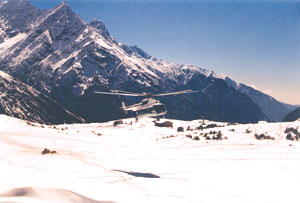 A six-year-old row over direct flights between Kathmandu and Syangboche has resurfaced after the Civil Aviation Authority announced plans to lengthen the airstrip at 4,000 m to accommodate short take-off and landing (STOL) aircraft.
A six-year-old row over direct flights between Kathmandu and Syangboche has resurfaced after the Civil Aviation Authority announced plans to lengthen the airstrip at 4,000 m to accommodate short take-off and landing (STOL) aircraft. Villagers living between Lukla and Namche Bazar on the Mt Everest trail fear they will lose their livelihood if trekking and cargo traffic flies directly into Syangboche, bypassing Lukla.
"It means trekking groups, lodges, porters will lose about five days worth of business," says Penoorie Sherpa, Chairman of Lukla Village Development Committee. Flying to Syangboche will shorten the popular Everest trek from 14 days to nine days roundtrip and the traditional zopkio and yak trains which transport goods will be out of business, he says.
This month, businesses and representatives from Namche, Lukla, Phakding and Kharikhola gathered at Namche to discuss the repercussions of having an airport at Syangboche. In a memorandum submitted to the tourism ministry and cced to 30 organisations, including airline operators,UNESCO, and the civil aviation authority, the Namche VDC says the extension of the airport will benefit 5 percent of Khumbu's businessmen but affect the livelihoods of 95 percent of the local population.
Namche Bazar, which is the business hub of the Khumbu region could potentially benefit from the airport, but lodge owners there aren't happy either. Syangboche airstrip is a half-hour climb above Namche. "It definitely means less business," says Jangbu Sherpa, proprietor of Caf? Danfe, one of Namche's numerous lodges. "As tourists usually spend more money and time on their return treks, we're going to lose that income if they fly out from Syangboche."
The Everest region got a boost when Sir Edmund Hillary converted potato fields near a small village called Lukla into the famous airstrip with its inclined runway. Suddenly, the two-week walk via Lamosangu and Jiri was shortened, and the entire Everest region became accessible. Now, with the airport higher up the valley in Syangboche, the upper Khumbu will be even easier for tourists to visit. Lukla villagers fear they will suffer the same fate as the villages in Junbesi and along the Jiri trail after trekkers and mountaineers started flying directly to Lukla.Lukla has about 150 lodges and hotels that cater to trekkers making a night stop to catch the next morning's flights to Kathmandu.
The decision to refurbish the Syangboche airstrip appears to be the result of a falling out between tourism minister Bal Bahadur KC and his party cadre in Lukla who staged a demonstration against him in October last year when the newly black-topped runway and new terminal building in Lukla were inaugurated.
 KC's erstwhile loyalists were unhappy about the shoddy construction of the new supporting wall built along the northern edge of the runway which they said already looks fragile, and may not survive this monsoon. Penoorie also doesn't see the logic in having two airports within five minutes flying time from each other. "Money should be spent on renovating airports like Kagel and Phaplu which are in bad condition and on repairing roads and building bridges," the Lukla VDC chairman told us.
KC's erstwhile loyalists were unhappy about the shoddy construction of the new supporting wall built along the northern edge of the runway which they said already looks fragile, and may not survive this monsoon. Penoorie also doesn't see the logic in having two airports within five minutes flying time from each other. "Money should be spent on renovating airports like Kagel and Phaplu which are in bad condition and on repairing roads and building bridges," the Lukla VDC chairman told us. Syangboche airport falls within the Sagarmatha National Park, a world heritage site, and there are questions about the impact on wildlife of increased air traffic and noise. There are also technical questions about operating a STOL airport at such an altitude, where wind and mist may affect flights.
The spat between KC and his party cadre in Lukla has worked to the benefit of those living above Namche, who don't see the Syangboche airstrip as such a bad thing. "We have to look at the larger economic picture, of expanding tourism potential," says Ang Tshering Sherpa, a Khumjung resident and proprietor of Asian Airlines who also owns a string of hotels along the Everest trail.
"People will continue to fly into Lukla for acclimatisation, maybe 40 percent will fly out of Syangboche," says Ang Tshering. Because of Syangboche's higher altitude, aircraft cannot take off fully-loaded and this will push up airfares and restrict the numbers of those flying in.
Ang Tshering estimates 20,000 additional trekkers will visit the area once Nepal and China allow trekkers to pass through the Nang-pa Pass on the Nepal-Tibet border. The high pass north of Thame is the traditional trade route used by Tibetan traders who sell their wares at Namche's weekly Saturday market. Syangboche could possibly get a bulk for this traffic.
But Lukla locals say they will try to ensure Syangboche never opens for STOL traffic. They are even prepared to repeat their 1997 sit-ins on the runway to protest cargo and passenger helicopters flying tourists directly to Syangboche. The runway improvement has already been delayed because of vandalism of some construction equipment. "We first have to fix the equipment that was damaged by some unhappy locals," says Shankar Pradhan, a Civil Aviation engineer overseeing the project. The damage to an excavator and some hydraulic pipes has amounted to Rs 200,000-300,000. There are now police guarding the equipment.
The plan is to extend the inclined current airstrip, currently 400 m long, on both sides till 630 m and the approach path has to be re-aligned to take into account prevailing wind.


